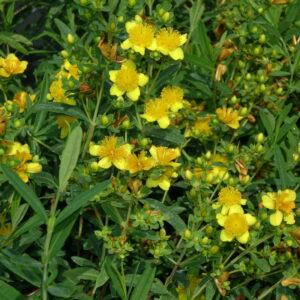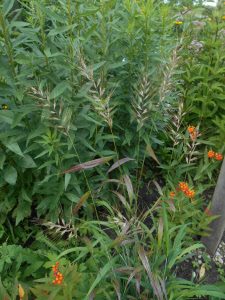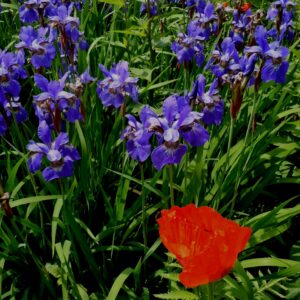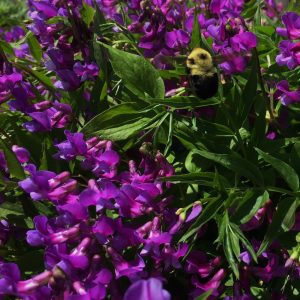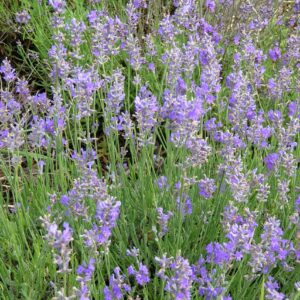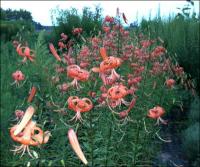Drought, Xeric & Dry Soil Plants
Showing 65–72 of 132 results
-
Hypericum kalmianum Kalm’s St. Johns wort SHRUB Z 4-7
Yellow saucers with a puff of showy prominent stamens in mid to late summer, compliment the glaucous blue leaves on this mounding shrub.
Yellow saucers with a puff of showy prominent stamens in mid to late summer, compliment the glaucous blue leaves on this mounding shrub.
Size: 3-4’ x 3-4’
Care: sun to shade in well-drained to moist well-drained soil. Blooms on new growth so prune in late winter to early spring as far back as you wish.
Native: Quebec to WI, S. to IL, Wisconsin native.
Wildlife Value: attracts bees and butterflies
Awards: Great Plants for Great PlainsThe name Hypericum comes from Greek hyper meaning “above”, and eikon, meaning “icon or image”. The yellow flowers of some species were placed above images to ward off evil spirits, and according to legend, Satan pierced the leaves in revenge. This species collected by & named for Peter Kalm, Swedish plant hunter, on his expedition in North America before 1753. Offered for sale in Bartram Garden’s 1783 Broadside, America’s 1st plant catalog. David Douglas (Douglas fir guy) also collected this at Niagara Falls per William Jackson Hooker.
**LISTED AS OUT OF STOCK BECAUSE WE DO NOT SHIP THIS ITEM. IT IS AVAILABLE FOR PURCHASE AT OUR RETAIL LOCATION.
-
Hystrix patula syn. Elymus hystris var. hystris Bottle brush grass Z 5-9
June thru fall bears 6” long spikes looking like bottle brushes
OUT OF STOCK- PLEASE EMAIL FOR AVAILABILITY
June thru fall bears 6” long spikes looking like bottle brushes.
Size: 2-3’ x 12-18”
Care: sun to part shade in dry to moist well-drained soil - tolerates dry shade
Native: Nova Scotia S to Virginia, W to ND and OK.
Wildlife Value: Birds eat seedsHystrix from the Greek (‘hedgehog’) meaning “with spikes” or “bristly” describing the flowers and patula means “spreading.” Collected before 1794. In 1913 L H Bailey wrote, “sometimes used for lawn decoration and for borders.”
-
Iris siberica Siberian Iris Z 4-9
sword shaped leaves with blue, purple or lilac Iris flowers
Narrow, sword shaped leaves with blue, purple, or white Iris flowers in June.
Size: 3-4' x S 12" and spreading
Care: Full sun moist well-drained soil. Deer resistant, Walnut toxicity resistant and drought tolerant.
Native: Eastern Siberia
Awards: England's Royal Horticultural Society Award of Merit.Iris is named after the Greek goddess who accompanied the souls of women to the Elysian Fields by way of the rainbow. Her footprints left flowers the colors of the rainbow. Iris means the “eye of heaven.” The iris is the flower of chivalry, having “a sword for its leaf and a lily for its heart.” Ruskin. Siberian Irises first cultivated in European gardens in the 1500’s. Blue Siberian Iris was introduced to the U.S. in 1796. Cultivated by Washington at Mount Vernon.
-
Knautia macedonica syn. Scabiosa rumelica Pincushion plant Z 5-9
Claret pincushions float at the tips of airy wands all summer & fall
Claret pincushions float at the tips of airy wands all summer & fall
Size: 2- 3’ x 10”
Care: sun in well-drained soil. Keep compact by cutting back to 10” in spring, if you wish
Native: Central Europe
Wildlife Value: attracts butterflies and beesKnautia named for German doctor & botanist Christoph Knaut (1656-1716) who published a method of classifying plants. Collected before 1879
-
Lathyrus vernus Spring vetchling, Spring pea, Spring vetch Z 4-9
Bushy plants bear showy, red-purple pea-like blooms age to rich purple in March-June. Ephemeral, dying back in August when you can cut it back. Spring gem.
OUT OF STOCK
Bushy plants bear showy, red-purple pea-like blooms age to rich purple in March-June. Ephemeral, dying back in August when you can cut it back. Spring gem.
Size: 12” x 12”
Care: sun in north to shade in south, moist well-drained soil. Drought tolerant once established
Native: No. Europe - Siberia
Awards: Royal Horticultural Society Award of Garden Merit, Elisabeth Carey Miller Botanical Garden Great Plant PicksIntroduced to gardens before 1629. Parkinson called it “Blew Everlasting Pease.”
-
Lavandula angustifolia ‘Munstead’ Z 5-9
Very fragrant, compact form of Lavender
June and rebloom in late summer, very fragrant lavender spikes
Size: 12-18” x 12-18”
Care: Sun, well drained moderately fertile soil
Native: Selection of Western Mediterranean nativeThis selection introduced to gardens in 1916. Name is Latin from “lavare” meaning to wash because Romans used lavender to scent their baths. Ancient Phoenicians used lavender to make perfume. Cultivated in Islamic gardens by 1050 A.D. Queen Elizabeth, I ate lavender conserve, made by adding sugar to the flowers while Charles VI of France stuffed pillows with lavender and sat on them. Culpepper, a 16th century English herbalist, wrote that lavender grew in almost every garden and cured headache, apoplexy, dropsy, fainting, toothaches, and “passions of the heart.” Jefferson grew it with herbs at his farm, 1794.
-
Lilium lancifolium Tiger lily, in Japan called “oniyuri” Z 2-7
Late summer, orange, recurved blossoms with black spots
Late summer, orange, recurved blossoms with black spots
Can not ship to: Delaware and Maryland.
Size: 3-4' x 12"
Care: Sun to part shade in any soil
Native: AsiaLilium was named for the Greek word for smooth, polished referring to its leaves. The Tiger lily was in Chinese literature as long ago as the 10th century. The Chinese grew it in rows as a vegetable and wrote it brought the pained dragon to life. First described for the West by Englebert Kaempfer, physician to Dutch East India Co. on Deschema Island in the 1690’s. William Kerr sent the Tiger lily from Canton China to Kew in England in 1804. First Asian lily imported to America. A Tiger lily grew in Wonderland’s looking glass garden where it told Alice “We can talk…when there is anybody worth talking to.”
-
Limonium latifolium syn. Limonium platyphyllum Sea lavender, Statice latifolia Z 2-8
Airy lavender blue panicles from mid to late summer. Leathery foliage turns reddish in fall.
Airy lavender blue panicles from mid to late summer. Leathery foliage turns reddish in fall.
Size: 24-30” x 24”
Care: Full sun in well-drained soil
Native: Russia, Bulgaria & Romania
Wildlife Value: Deer resistant. Attracts bees and butterflies.Limonium is Greek meaning “meadow” and latifolium means “wide leaf”. This was identified by Dioscorides in DeMaterica Medica for medicinal use around 70 A.D. Cultivated in gardens since 1700’s. Formerly used to repel moths and cure canker sores.

